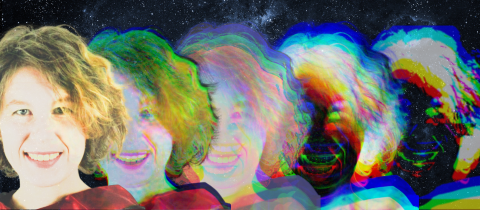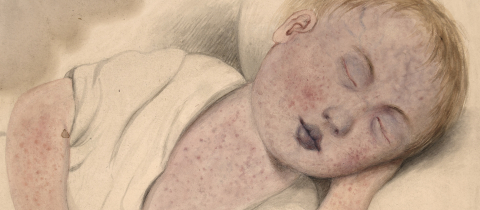Our social media feeds are filled with buzzwords like anti-inflammatory, detoxifying, or antimicrobial. Chlorophyll water is no exception. There are countless social media posts claiming that drinking a glass of bright green chlorophyll water every day will banish your acne. The claims go beyond skin care to bad breath and cancer prevention, which OSS writer Jonathan Jarry investigated in an earlier article. At first, I dismissed this trend as complete blasphemy. But behind the nonsense there is a plethora of interesting plant science and important lessons about evidence-based medicine.
Although social media captions proclaim chlorophyll’s purpose is to detox and cleanse, chlorophyll’s original purpose lies in leaves. Chlorophyll is a large molecule found in all green plants, from freshwater algae to old-growth trees. It is a special type of molecule called a pigment. Like the name suggests, pigments give colour to objects because they reflect certain ranges of light. Chlorophyll reflects green light and absorbs blue and red light, giving plants their characteristic green hue.
Chlorophyll plays an essential role in photosynthesis, which as you may remember from biology class, is a series of chemical reactions that take place within a plant. The overall photosynthesis equation is simple: plants take in carbon dioxide gas and water from the environment. They use energy from sunlight to convert these two ingredients into glucose and oxygen. Glucose is one of the building blocks of stems, leaves, and all things plant. Oxygen is essential to animal (and human!) life, and one of the many reasons why deforestation is harmful.
Behind the scenes of the simple photosynthesis reaction is a bunch of complex biology. Chlorophyll plays a critical role – it absorbs light energy, or photons, and converts it into chemical energy in the form of electrons. The secret to chlorophyll’s success lies in its chemical structure: chlorophyll is a large, carbon-rich molecule with many chemical bonds and electrons. You can imagine chlorophyll as a big factory full of well-meaning but tired employees, who we’ll use to represent electrons. When sunlight hits the factory, it energizes one of the employees causing them to jump up and start working at a nearby site. In scientific terminology, when sunlight hits a chlorophyll molecule, one of the electrons absorbs the energy and uses it to jump out of the chlorophyll molecule and into other photosynthesis reactions.
Chlorophyll’s unique chemical properties are the reason we can eat spinach, hike through a forest, and breathe oxygen. Chlorophyll’s role in photosynthesis was carefully crafted over years of evolution. The same can’t be said for chlorophyll products that pop up on our social media feeds.
While a miracle acne-fighting green drink would be amazing, there is no scientific research backing the claim that chlorophyll water clears your skin. However, there is a small amount of clinical evidence that supports using chlorophyll-like molecules as part of photodynamic therapy. This type of acne therapy has been around for about 20 years, and dermatologists have been conducting clinical trials to determine the therapy’s effectiveness. There are two components to photodynamic therapy: first a special product called a photosensitizer is applied to the skin, then dermatologists shine light on the patient’s skin to activate the photosensitizer. Does photodynamic therapy sound familiar? That’s because there are some general similarities between photodynamic therapy and photosynthesis! Both photosynthesis and photodynamic therapy involve shining light onto chlorophyll to excite electrons. In photosynthesis, those electrons go on to power chemical reactions. In photodynamic therapy, scientists think that excited electrons from chlorophyll produce reactive oxygen species, or unstable molecules that can cause cell death. The reactive molecules selectively destroy acne tissue, leading to breakout-free skin.
Right now, ALA is the only FDA-approved photosensitizer for acne, but there are a few small clinical trials studying chlorophyll as a photosensitizer. A 24-subject clinical trial found that applying chlorophyll before light therapy caused more reduction in acne than light therapy alone. Given the small size of the trial and lack of a control arm, scientists need to do more research before recommending photodynamic therapy with chlorophyll as a first-line treatment. Most importantly, photodynamic therapy is not the same as drinking chlorophyll water! Articles claiming that chlorophyll water is backed up by clinical research are misguided – there is a big difference between a dermatologist applying chlorophyll to your skin during photodynamic therapy and drinking chlorophyll in hopes of banishing your blemishes.
There is still a lot of uncertainty surrounding how photodynamic therapy works, and if it should be prescribed as a first-line treatment for acne. But one thing is for certain, drinking chlorophyll will not clear your skin. If chlorophyll really did have this wondrous effect, we wouldn’t have to worry about blemishes because every green vegetable we consume is loaded with chlorophyll!
Maya McKeown recently graduated from McGill University with a Bachelors of Science (BSc) in Neuroscience and a minor in Mathematics.







